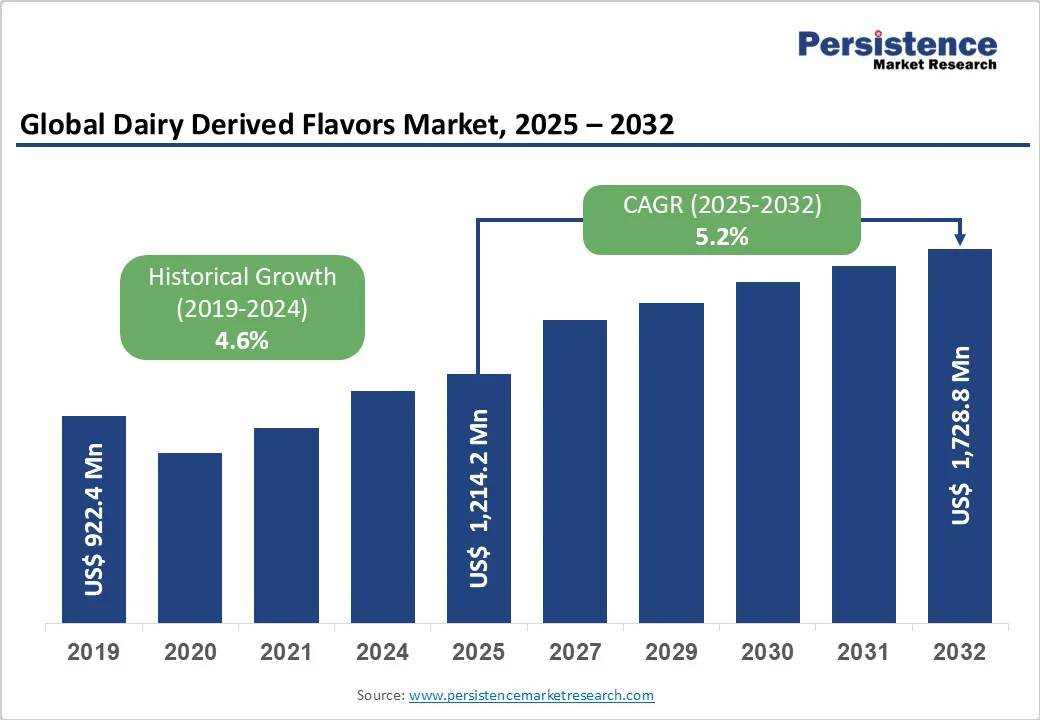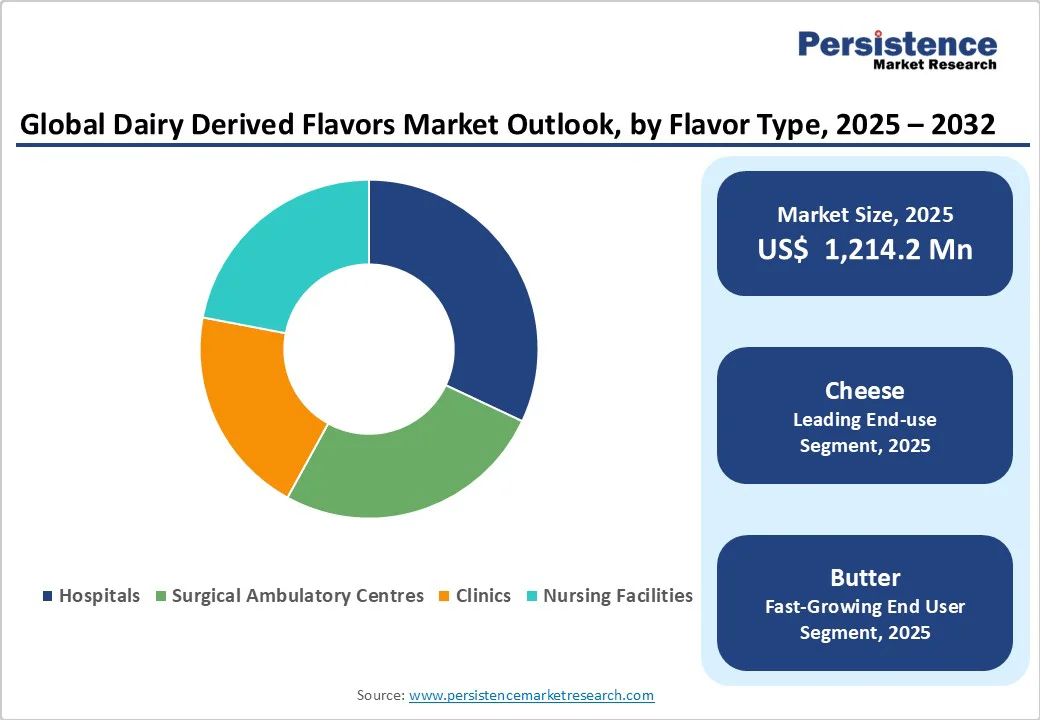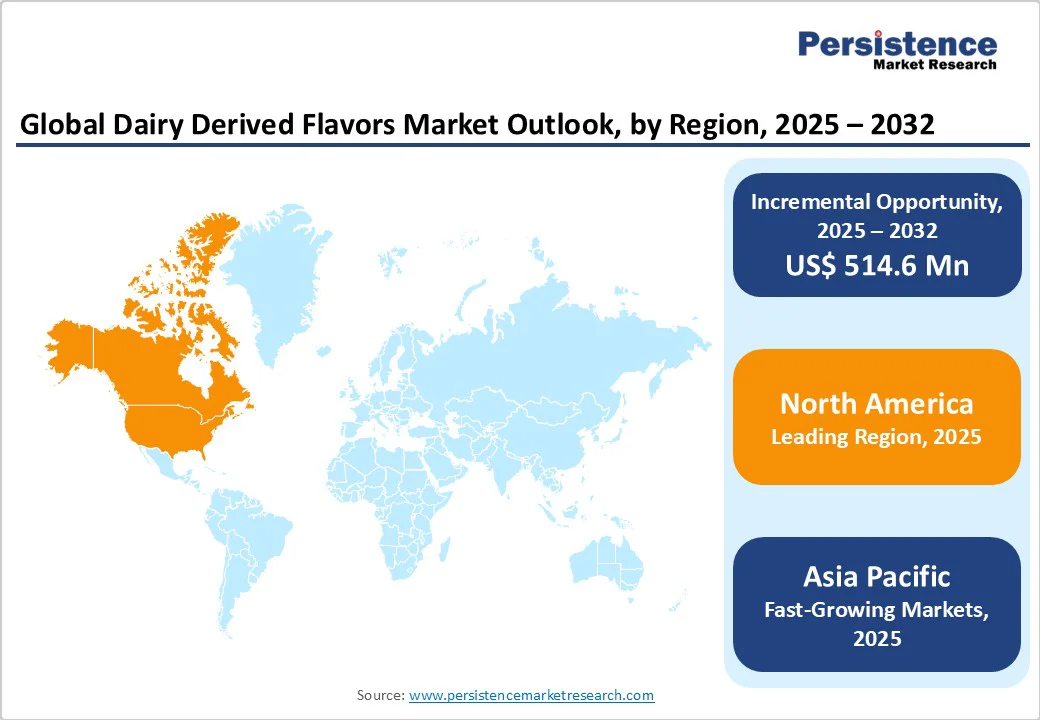ID: PMRREP22621| 190 Pages | 20 Oct 2025 | Format: PDF, Excel, PPT* | Food and Beverages

The global dairy-derived flavors market size is likely to be valued at US$1214.2 million in 2025. It is projected to reach US$1728.8 million by 2032, growing at a CAGR of 5.2% during the forecast period 2025 - 2032. The strong growth of the market is driven by the rising demand for natural and authentic taste profiles in food and beverages.
These flavors, extracted from milk, butter, cheese, and cream, enhance richness and mouthfeel across applications such as bakery, confectionery, snacks, and beverages. Increasing consumer preference for clean-label and organic ingredients, along with innovation in flavor technology, is further boosting market expansion.
The growing popularity of dairy-based indulgent products and plant-dairy hybrid formulations is also fueling the demand for such flavors and textures.
| Key Insights | Details |
|---|---|
| Dairy Derived Flavors Market Size (2025E) | US$ 1,214.2 Mn |
| Market Value Forecast (2032F) | US$ 1,728.8 Mn |
| Projected Growth (CAGR 2025 to 2032) | 5.2% |
| Historical Market Growth (CAGR 2019 to 2024) | 4.6% |

Manufacturers are coming up with new and innovative products to increase their market share across the world. Dairy product manufacturers are also developing new products, which can change the course of the dairy product industry.
For instance, dairy-product manufacturers have introduced drinkable yogurt in the North American market, and it has become the most popular dairy product in a very short period. Consumers are still unfamiliar with the product and to increase their interest in such innovative products, manufacturers need to come up with flavor-based solutions.
The drinkable yogurt category seems to have a lot going for it as a result of its fermentation, convenience, and functional properties. However, at the same time, drinkable yogurt accounts for a very small percentage of total yogurt sales. Consumers rate drinkable yogurt as tasty, exciting, fun, and an indulgent treat, which packs in nutrients as well as taste.
Brands that are providing drinkable yogurts are focusing more on functional benefits and end up lagging in flavor innovations. Flavor is always the key, but especially so in a category such as this one, where consumers still lack familiarity, so flavor innovation and consumer education are key factors. Producers are looking at an immensely lucrative opportunity in this new and emerging segment to develop new flavors of drinkable yogurt.
Lactose intolerance and dairy allergies are becoming major barriers to the dairy-derived flavors market growth. With increasing awareness about digestive health, a large population segment, particularly in Asia and Africa, is avoiding traditional dairy-based products.
Lactose-intolerant consumers experience discomfort such as bloating or cramps after dairy consumption, while those with milk protein allergies face more severe reactions, prompting a shift toward non-dairy alternatives.
This growing sensitivity has encouraged manufacturers to reformulate products or switch to plant-based or enzyme-treated variants, reducing reliance on conventional dairy flavors. As consumer preferences lean toward lactose-free and allergen-friendly foods, the demand for authentic dairy-derived flavors declines, compelling flavor producers to innovate in hybrid or dairy-free flavor formulations.
The purchasing pattern of consumers has forced manufacturers to use natural ingredients in products. Artificial ingredients reduce the cost of the product but cause serious health problems to the human body. With growing health awareness, consumers are demanding more and more products manufactured using only natural ingredients. This shift of consumers towards natural ingredients is propelling the demand for natural dairy-derived flavors.
Dairy-derived flavors are available in both artificial and natural dairy-derived forms. The extraction of natural flavor is a very complex process. Still, technological advancements in the flavor industry have made this procedure quite simple, which results in more production in less time. In response, manufacturers are successfully catering to the increasing demand for natural dairy-derived flavors across the globe.
Cheese flavor is anticipated to dominate the dairy-derived flavors market, accounting for around 45% revenue share in 2025 due to its strong versatility, rich taste, and universal appeal across diverse food categories. It is widely used in snacks, sauces, bakery, and ready-to-eat meals, providing a savory umami profile that enhances product indulgence.
The rising popularity of cheese-flavored snacks, frozen meals, and fast-food products has accelerated its demand worldwide. Moreover, cheese flavor offers an affordable and stable alternative to natural cheese, ensuring consistent taste and longer shelf life.
Advancements in flavor technology now allow manufacturers to replicate the authentic, creamy notes of aged or specialty cheeses, further broadening their application. With evolving consumer tastes favoring bold, rich, and comforting flavors, cheese remains the preferred choice in both traditional and modern cuisines.
Powdered dairy flavors are set to rule the market in 2025 due to their long shelf life, easy handling, and superior stability compared to liquid or paste forms. They are highly compatible with dry food formulations such as instant soups, snacks, bakery mixes, confectionery, and ready-to-drink powders.
Manufacturers prefer powder flavors as they are cost-effective, lightweight for transportation, and offer consistent flavor release during processing. Aside from this, the growing demand for convenience and packaged foods further boosts the use of powdered dairy flavors. Their versatility in both sweet and savory products, along with easy storage and clean-label formulation potential, makes them the most widely adopted form in the dairy-derived flavor industry.

In North America, especially the U.S., the dairy-derived flavors market is experiencing robust growth, fueled by rising consumer preference for authentic, creamy, and indulgent taste experiences. Cheese and butter flavors lead demand due to their extensive use in snacks, bakery, frozen foods, sauces, and ready-to-eat meals.
The region’s well-established dairy sector enables manufacturers to innovate natural, clean-label, and organic flavor solutions, meeting health-conscious consumer needs. Consumers are increasingly favoring functional and protein-enriched products, prompting the incorporation of dairy flavors in beverages, meal replacements, and nutritional bars.
The surge in plant-based and hybrid dairy products has created opportunities for dairy-identical flavors that mimic traditional taste profiles. Manufacturers across the U.S. are also leveraging advanced flavor technologies such as microencapsulation and AI-driven formulation to improve flavor stability, shelf life, and consistency.
The Asia Pacific dairy-derived flavors market is anticipated to grow the fastest by 2032, driven by rising urbanization, changing dietary habits, and increasing disposable incomes. Major Asian economies such as China, India, Japan, and South Korea are witnessing a growing demand for flavored dairy beverages, snacks, and bakery products.
Cheese and milk-based flavors are gaining popularity among younger consumers and the expanding middle class seeking indulgent yet convenient foods. The market is also fueled by the rise of Western-style fast foods, ready-to-eat meals, and functional dairy products enriched with protein or probiotics.
Manufacturers are investing in natural and clean-label flavor solutions to cater to health-conscious trends. Additionally, evolving cold chain infrastructure and retail expansion, including e-commerce platforms, are facilitating greater distribution, making the Asia Pacific a key growth hotspot for dairy-derived flavors.

The global dairy-derived flavors market is highly competitive, dominated by leading multinational players such as Kerry Group, Givaudan, Symrise, and International Flavors & Fragrances (IFF).
Companies focus on product innovation, natural and clean-label flavor solutions, and strategic partnerships to strengthen their market presence. Mergers, acquisitions, and collaborations with food and beverage manufacturers are common strategies to expand portfolios and geographic reach.
The global dairy derived flavors market is projected to reach US$ 1,214.2 million in 2025.
Increasing preference among consumers for clean-label, natural, and organic ingredients, boosting the adoption of dairy-derived flavors, is driving the market.
The market is poised to witness a CAGR of 5.2% between 2025 and 2032.
Developing flavors that combine dairy and plant-based notes to cater to flexitarian consumers is a major market opportunity.
Kerry Group, Givaudan SA, International Flavors & Fragrances, Inc., and Archer Daniels Midland Company are few of the key market players.
| Report Attributes | Details |
|---|---|
| Historical Data/Actuals | 2019 - 2024 |
| Forecast Period | 2025 - 2032 |
| Market Analysis | Value: US$ Mn, Volume if Applicable |
| Geographical Coverage |
|
| Segmental Coverage |
|
| Competitive Analysis |
|
| Report Highlights |
|
By Flavor
By Form
By Nature
By Region
Delivery Timelines
For more information on this report and its delivery timelines please get in touch with our sales team.
About Author